
Season Seven







 MICHELLE MAIN DIRECTOR OF OPERATIONS - HOTEL CASA DEL MAR
MICHELLE MAIN DIRECTOR OF OPERATIONS - HOTEL CASA DEL MAR
I grew up in Southern California and have always been in love with the views and its coastal luxury hotels. Shutters on the Beach and Hotel Casa del Mar are particularly unique and I feel so lucky to have had the chance to work at both of them over the last four years! Casa has stolen my heart. It’s historic, it has a European sensibility, and it has a beach-y Santa Monica vibe all rolled into one. Sophisticated, but far from stuffy, with a touch of whimsy.
Long before I chose hospitality as my major at Arizona State University, my family, friends, and I were patrons of Shutters and Casa. It was always on our list to take outof-town guests here—the atmosphere and view were so relaxing and beautiful. The walks on the beach before or after a drink or a meal are an added bonus.
Guests often ask me what to do and where to go. I let them know that all my favorite places are right here in Venice and Santa Monica. I love to shop on Abbott Kinney and Montana Avenue. The city works hard to preserve the independent and eclectic spirit of the retail and restaurant experiences of both streets, so the boutiques are quaint and feature a lot of local designers and artists.
For dining, I cannot get enough of Gjelina and Fia. They are not easy to get into, but somehow our Concierge team usually manages to secure a reservation for me. There are so many world-class culinary dining options in L.A., you could eat out every night and never go to the same restaurant twice.
I welcomed out-of-town visitors recently and we had a Santa Monica dine-around. One night we enjoyed a dinner and live music at Terrazza (of course!), the next it was Tar & Roses, another at Rustic Canyon, and the last night, dinner al fresco on The Patio at sunset.
Our days were spent on bikes, at the Pier, or near the water. We had to stay active—we had a lot of calories to burn!
TYLER MAXWELL
FRONT OFFICE MANAGER - SHUTTERS ON THE BEACH
My family and I moved to Los Angeles from Connecticut when I was 11 and I was immediately awestruck by the California Coast. I fell in love with the ocean, and my passion for a wellness-based lifestyle was born.
Being outside and enjoying our endless summer weather takes on a variety of forms throughout the year. There are so many outdoor activities in L.A. County’s beach cities to keep you infused with Vitamin D and fresh air 365 days a year. Some of my favorites are biking The Strand, beach yoga, shopping along Montana and Abbott Kinney or driving up the PCH to dine al fresco in Malibu.
Preferring to be outdoors made working at Shutters a logical choice. With all our balconies, patios and terraces, I never feel like I’m inside a hotel. It feels more like I am the host for our owners’ luxury beach house in Santa Monica.
I do travel inland on occasion, just to hit the links. Golf is key to my wellness regimen, and I like to stay well versed and informed on the area’s courses to help our guests decide what’s right for them. The choices can be overwhelming—there are 600 courses in Southern California, a golfer’s paradise.
Personally, I like to drive north to Ventura County to play Rustic Canyon, Soule Park and Olivas Links. Olivas is easily accessible via the PCH and enjoys cool ocean breezes.
It’s a perfect day trip up the coast. Our guests don’t have to miss the sunset on their way back for dinner or a nightcap at Shutters.
Tidings from ETC Hotels


REGENERATION 14 Luxury Brands Hang 10 26 Sea of Enlightenment WELLSPRING 42 Dog Days 56 Santa Monica Sneakerheads 66 Art of the Matter PEOPLE 76 Preserving Roots 82 Black Santa Monica FROM ETC HOTELS 90 Where the Pacific Ocean Meets the Mediterranean Sea 94 Après Beach ABOUT THE COVER A famous, vintage “Hi Spy Viewing Machine” on the Santa Monica Pier. Image by Blake Abes. 06 Table of Contents

333 BRISTOL ST BEVERLY CENTER 8500 BEVERLY BLVD
SHEILA ATIM Actor, Musician, Writer & Composer SOUTH
COAST PLAZA

@shuttersca
Facebook /CasadelMar /ShuttersontheBeach
08 WAVES TV: SANTA MONICA HAS GONE TO THE DOGS And that’s a good thing. Watch every episode of Waves, catch up on original stories, and encounter new seasonal content online. waves.edwardthomasco.com SOCIALIZE WITH SHUTTERS ON THE BEACH AND HOTEL CASA DEL MAR
Instagram @hotelcasadelmar
Table of Contents Online image by Blake Abes

CEO & PUBLISHER
Jason Cutinella
GLOBAL EDITORIAL DIRECTOR
Brian McManus
DESIGNER
Coby Shimabukuro-Sanchez
CONTRIBUTING EDITOR
Urs Baur
CONTRIBUTING PHOTOGRAPHER
Tim Aukshunas
CREATIVE SERVICES
Gerard Elmore VP FILM
OPERATIONS
Joe V. Bock CHIEF RELATIONSHIP OFFICER
Merri Gruesser VP GLOBAL PARTNERSHIPS & DEVELOPMENT
ADVERTISING
Mike Wiley VP SALES mike@nmgnetwork.com
Kristine Pontecha
CLIENT SERVICES DIRECTOR kristine@nmgnetwork.com
Published by: NMG Network 36 N. Hotel St., Ste. A Honolulu, HI 96817
©2024 by NMG Network, LLC. Contents of Waves are protected by copyright and may not be reproduced without the expressed written consent of the publisher. Waves assumes no liability for products or services advertised herein. Waves is a semiannual lifestyle publication of ETC Hotels.
10 masthead image by
Dave Herring


image courtesy of Schmidt Ocean Institute
“
Surfboards are always evolving, we’ve perfected ways to make them ride better.”
REGENERATION
Why luxury brands decided to hang 10.
Fashion brands are literally in deep water. Their branded surfboards are must haves for design mavens who shell out major coin for these ultra-luxury statement pieces that merge luxury fashion and functionality. Surfing’s worldwide popularity is the impetus behind these limited-edition, sport accessories created for the stylish surfer but also coveted by collectors, interior decorators, fashion fans, and those just looking to flex.
The boards are chic artworks emblazoned with instantly recognizable logos—Chanel’s interconnected Cs, Cynthia Rowley’s vibrant flower motifs, Louis’ iconic LV—interpreted by luxury casual clothing maker James Perse.
Traditional surfboard construction consists of a polyurethane foam blank at the core, surrounded by fiberglass cloth and glassed with polyester resin. Variations include length and shape, while some boards start with alternative kinds of blanks. Each element contributes to a board’s performance and maneuverability. Shapers are the skilled craftspeople who handshape (and sometimes paint) the boards after they’ve been cut, giving them unique
personalities. Most professional surfers have relationships with shapers who cater to their requests. The goal is to create a ‘magic’ surfboard, one that almost supernaturally enhances a surfer’s skills.
New York-based fashion designer Cynthia Rowley, known for her floral prints and youthful dresses and blouses, developed a passion for surfing when she learned her Montauk, Long Island home was located near a famed surf break. For years she’s experimented with materials, silhouettes, and shapes in creating her signature wetsuits made from sustainable neoprene, water-based glue and recycled materials. Rowley’s surfboards also combine fashion and practicality; the brand collaborated with top surfboard shaper Jeff ‘Doc” Lausch of Huntington Beach’s Surf Prescriptions to translate its lively aesthetic. The result: a made-to-order, egg-shaped board, with a pulled-in nose and tail, embellished with Rowley’s colorful prints.
“The boards are all made to be ridden,” explains Lausch. “The design is very userfriendly.” Unlike a longboard which is more difficult to maneuver when paddling out
14
Designer
Surfboards Create a Splash text
by Kathy A. McDonald
images by Tim Aukshunas, Willian Justen de Vasconcellos, and Knut Robinson
illustration by
Shelby Hohl


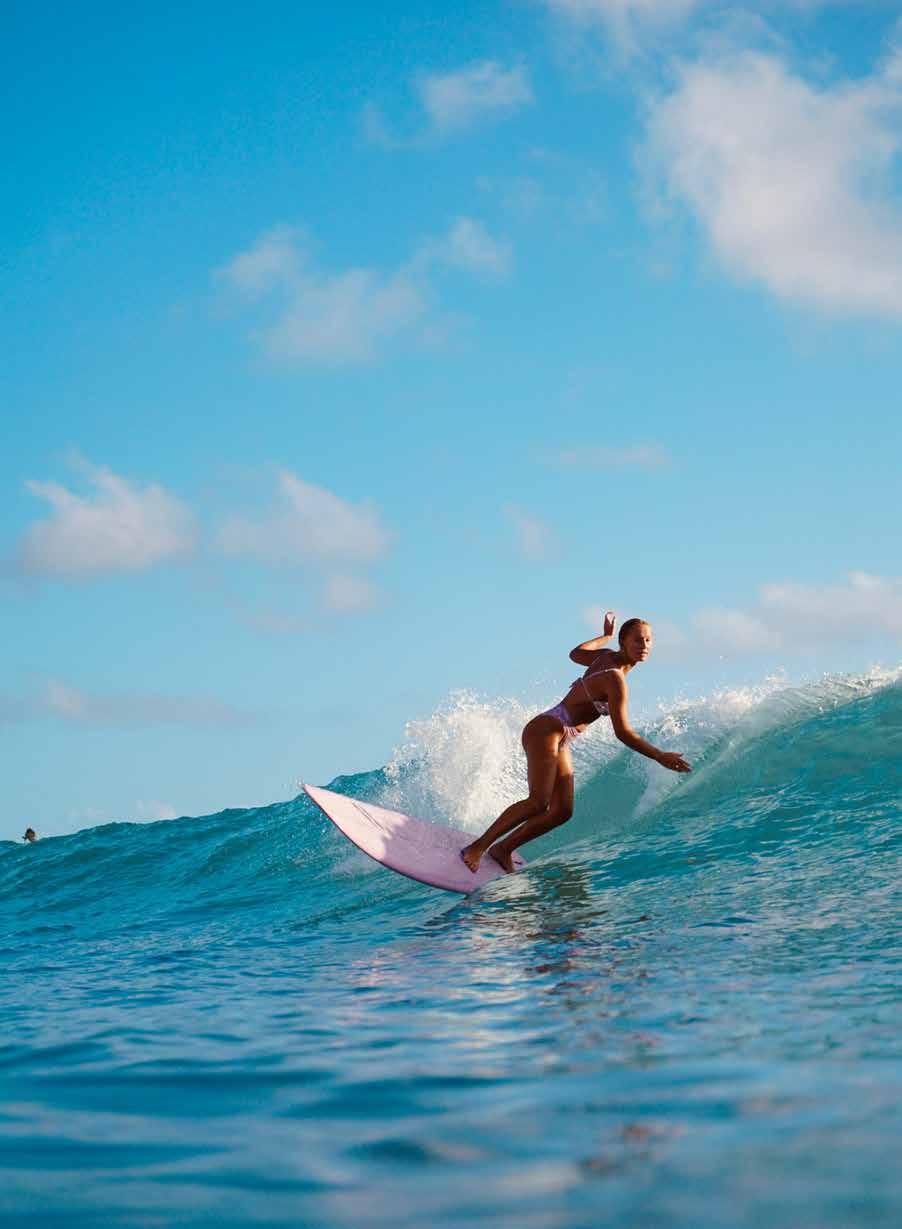
to waves, Rowley’s mid-length board at 7’ is easier to ride and most importantly, fun, says Lausch. Rowley’s design is printed directly on fiberglass, rather than fabric, and then adhered to the surfboard’s core where the colors and patterns really pop.
“It looks exactly the same as the fabric version,” explains Lausch. Prints go on the bottom of the board because the top or deck will be waxed. Lausch selects a prominent color from the print to paint matching pinlines on the deck. To finish, the board is glassed and then polished. “They look pretty cool,” Lausch affirms. Another awesome eye-catching outcome: boards match Rowley’s comely wetsuits.
Christian Dior, Louis Vuitton in collaboration with artist Yayoi Kusama, YSL Rive Droite, Juicy Couture, Shabby Chic and even Mercedes Benz have released upmarket surfboards in recent years. Often used for décor or promotions, all can catch waves too. Although most people may consider haute couture-inspired boards too spendy for everyday surf breaks.
Dior’s matte grey surfboard (offered online at $10,500) is a collaboration between France’s Notox (maker of eco-responsible surfboards) and the fashion house. A bold, 82”-long Dior graphic covers one-side of the surfboard is crafted using a bio-sourced foam core and plant-based resin. The wave rider comes with
a bespoke display stand, upcycled fabric cover plus branded Dior leash and fins. Customers can pair their swank surfboard with a Diorbrand, neoprene Vissla wetsuit, eco-crafted from limestone and upcycled plastic bottles.
Saint Laurent Rive Droite (the lifestyle arm of fashion house Yves Saint Laurent) released a collection of surfboards for summer 2023 made in collaboration with France’s UWL Surfboards. These beachy essentials mimic burnished wood to sensational effect and are $6,000 to start. The burnt wood version, with Saint Laurent typography, is a playful trompe-l’œil and features what looks like wood planks, artfully singed. Designs come from the mind of Anthony Vaccarello, Saint Laurent’s gifted creative director. There’s also a stand-up paddle board available sporting a distinctive look reminiscent of a vintage, wooden Chris-Craft cruiser with the classic boat’s signature typeface incorporated too.
Malibu-based James Perse’s adherence to barefoot luxury in his clothing and product designs, where minimalism meets the finest materials, is evident in his more than 20 surfboards in various colors and lengths. Perse’s understated, unusual colors and finishes make his boards pop. Intended for the ocean, surfboard performance is optimized by the slightly narrower nose and pulled in squash tail. A custom crafted stand offers an elegant display option.
18
Right: Image courtesy of Cynthia Rowley.




 Above and right: Legendary surfboard shaper Jeff “Doc” Lausch hard at work.
Above and right: Legendary surfboard shaper Jeff “Doc” Lausch hard at work.

The longboards (7’ 10” and 8’ 6”) are topped with various designs from a checkerboard Yosemite pattern, matching Perse’s outwear, to iconic symbols long associated with the Grateful Dead (Perse is a fan). There’s a striking matte black with a tonal stripe option, while some models have 1970s-era striping and others are available in subtle camouflage hues. As with all customized boards, they can’t be purchased off the shelf, but are instead made-to-order.
“Surfboards are always evolving, we’ve perfected ways to make them ride better,” explains Robert Weiner of Ventura’s Roberts Surfboards, a custom surfboard maker for more than 30 years. While swank logos stand out, precision cutting and shaping are key to giving a surfer the all-important tool to feel right and get tight in the pocket. “Surfers are on a never-ending quest for a magic board,” Weiner finds. And now they can ride an exquisite design while feeling the vibe.
24

Happy 50th to the Getty Villa Museum! Come celebrate with us as you explore the gardens, experience the ancient art, and enjoy the ocean breeze.
Text and design © 2023 J. Paul Getty Trust Get inspired FREE ADMISSION Plan your visit
Schmidt Ocean Institute creates a window into the wonders of the deep sea to inspire its protection.
“Eighty percent of our planet’s living space is the deep sea,” says marine scientist Dr. Peter Girguis in the video Sharing Why the Deep Matters, part of the Science Stories series on Schmidt Ocean Institute’s Youtube channel. A scientist aboard the Institute’s 2023 expedition to study hydrothermal vents off the coast of the Western Galapagos Islands, Dr. Girguis goes on to explain how our collective well-being depends on people’s willingness to work together for marine exploration and stewardship. By providing resources that empower Dr. Girguis and other researchers to advance deep-sea science—and documenting and sharing their incredible journeys of discovery—Schmidt Ocean Institute is energizing people from all walks of life to care about the fate of the ocean.
Launched in 2009 by former Google CEO Eric Schmidt and his wife Wendy, a philanthropist and competitive sailor, the 501(c)(3) private nonprofit foundation is built on the couple’s vision to expand ocean awareness and advance ocean health through tech-driven research.
“We realized that the biggest barrier to ocean science was access to a ship,” says
Wendy Schmidt, president of Schmidt Ocean Institute, to Waves in a statement. “By providing scientists with a state-of-the-art research vessel—at no cost, in exchange for making their discoveries and research publicly available and in real time—we can accelerate ocean science and exploration.”
Recognizing the complex and costly nature of deep-sea investigation, the foundation purchased an 83-meter German fisheries protection vessel, and commissioned a three-year, multi-million retrofit of the ship. In 2012, the state-of-the-art floating laboratory—named Falkor ferried or a character in the movie The Neverending Story—took to the sea to explore suboceanic realms and encounter the unknown.
Over a decade of service, Falkor has ferried 1,100 scientists and countless supporting crew on transoceanic expeditions of exploration with multifarious goals. Some examples of previous expeditions include the study of the long-term effects of the Deepwater Horizon oil spill, testing coral’s resilience to climate change, and mapping over half-a-million square miles of seafloor.
26 text by Lindsey Kesel images courtesy of Schmidt Ocean Institute Sea of Enlightenment
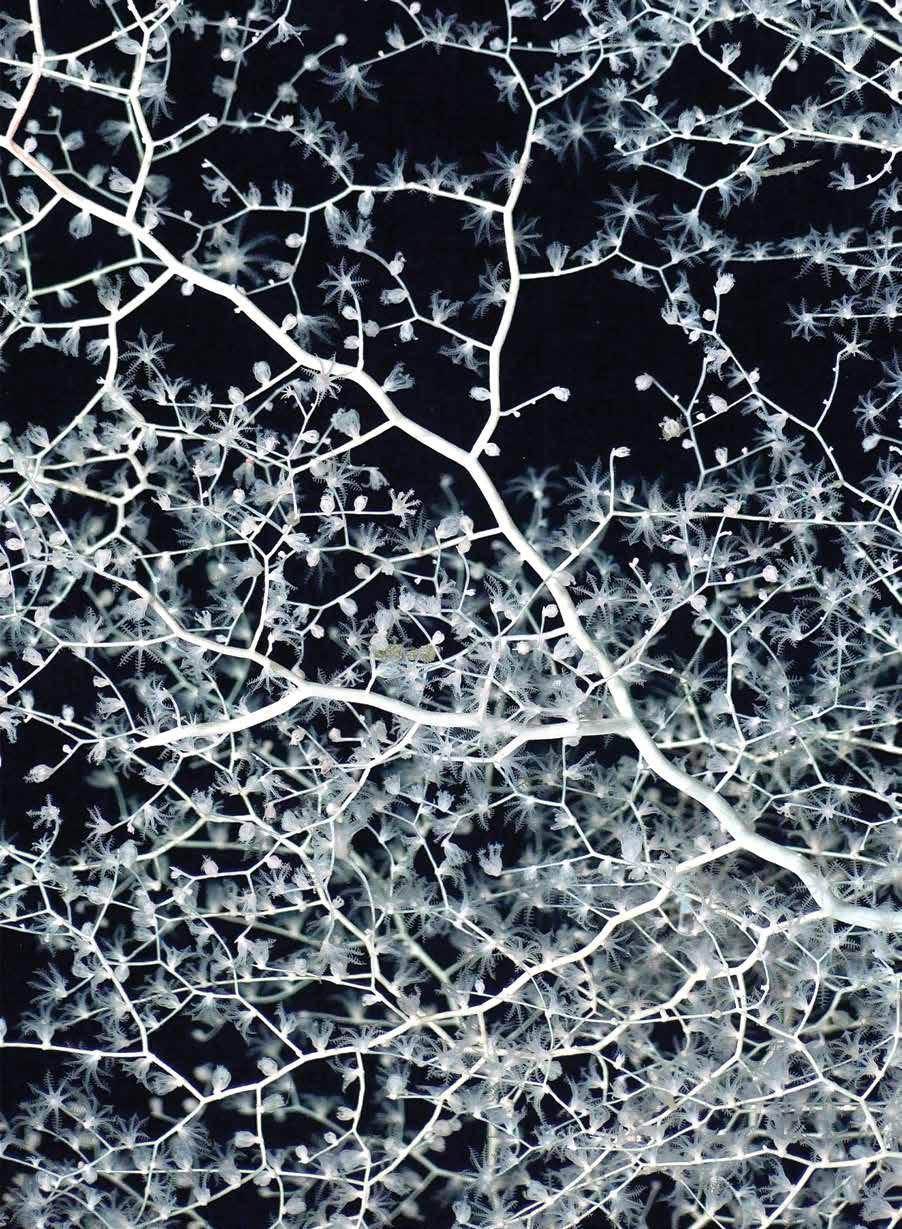


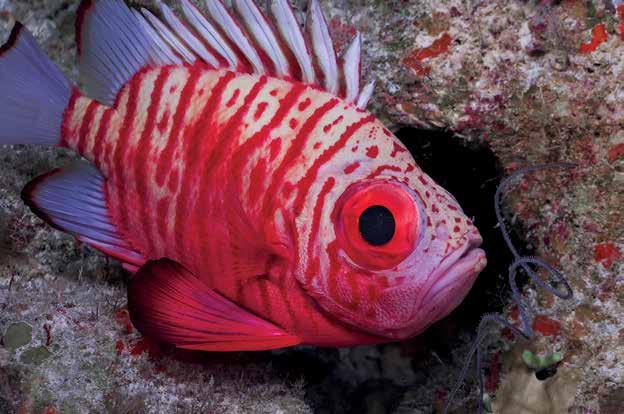
Photos in the story, courtesy of Schmidt Ocean Institute. Pg 27, A fine, highly branched golden coral - Scientists say it is possibly a new species.
Pg 28, During the Discovering Deep Sea Corals of the Phoneix Islands expedition, scientists made two rare sightings of a glass octopus, a nearly transparent species whose only visible features are its optic nerve, eyeballs and digestive tract.
Pg 29 A hermit crab on an octocoral (tentatively identified as a Plexaurid), observed during the “Necker Ridge: Bridge or Barrier?” expedition, carried out over September and October of 2019.
Pg 31, A rare deep-sea hydroid was discovered by Dr Nerida Wilson (Chief Scientist, Western Australian Museum) and her team on the Illuminating Biodiversity of the Ningaloo Canyons expedition.
Pg 33, Computer-generated view of the seafloor in the Mariana back-arc (white line) where R/V Falkor discovered 4 new hydrothermal vent fields and a recent volcanic eruption.
Pgs 34 - 35, A Pink precious coral (Hemicorallium) spreads its beautiful fan to catch nutrients that drift on deep ocean currents.
Pg 36, An octopus seen at 320 meters depth.
Pg 39, The first octopus of the Octopus Odyssey expedition is spotted, much to the excitement of the team.

For every endeavor, the foundation made Falkor available at no cost in return for the researchers’ promise to share all of their scientific findings with the public.
In March 2023, Schmidt Ocean Institute replaced its hallmark ship with Falkor (too)—a 110-meter global-class research vessel that can travel greater distances and host larger scientific groups—broadening the potential for breakthrough science at sea. Among the impressive suite of deep-sea probing technology on board, the new ship houses a Remotely Operated Vehicle (ROV) that functions as the eyes, ears, and arms for scientists underwater. A valuable asset to the ship’s burgeoning robotics program, SuBastian enables extensive data collection and versatile experimentation to depths of up to 4,500 meters.
During the first six months at sea, Falkor (too) embarked on six expeditions, each one yielding electrifying scientific discoveries including a hydrothermal vent field at East Pacific Rise, a submerged volcanic chain bordering Central America, a new octopus nursery off Costa Rica, and unearthed an entirely new ecosystem in the Pacific.
Near the Panama Canal, teams tested the dynamics of sinking microplastics using a custom-built Universal Filtering Object (UFO) instrument, and studied how microplastic pollution changed the deeper down it is.
In the waters off Puerto Rico, several potential new species of deep-sea corals were identified.
During each ROV dive, a high-tech camera setup captured the action as it unfolded, with “Divestreams” broadcast in real time on Schmidt Ocean Institute’s YouTube and social media channels.
Two novel outreach avenues—the Artistat-Sea program and the Ocean Rising initiative—are aimed at engaging people beyond the scientific community and stoking ocean intrigue via portals of existing passions. “We have the technology to harness and explore the weird and wonderful deep sea,” Dr. Carlie Wiener, Schmidt Ocean Institute’s Director of Communications, tells Waves over a Zoom call from her office in Honolulu. “Now we’re making the marvels of ocean science accessible by capturing beautiful imagery, sharing discoveries, and
32
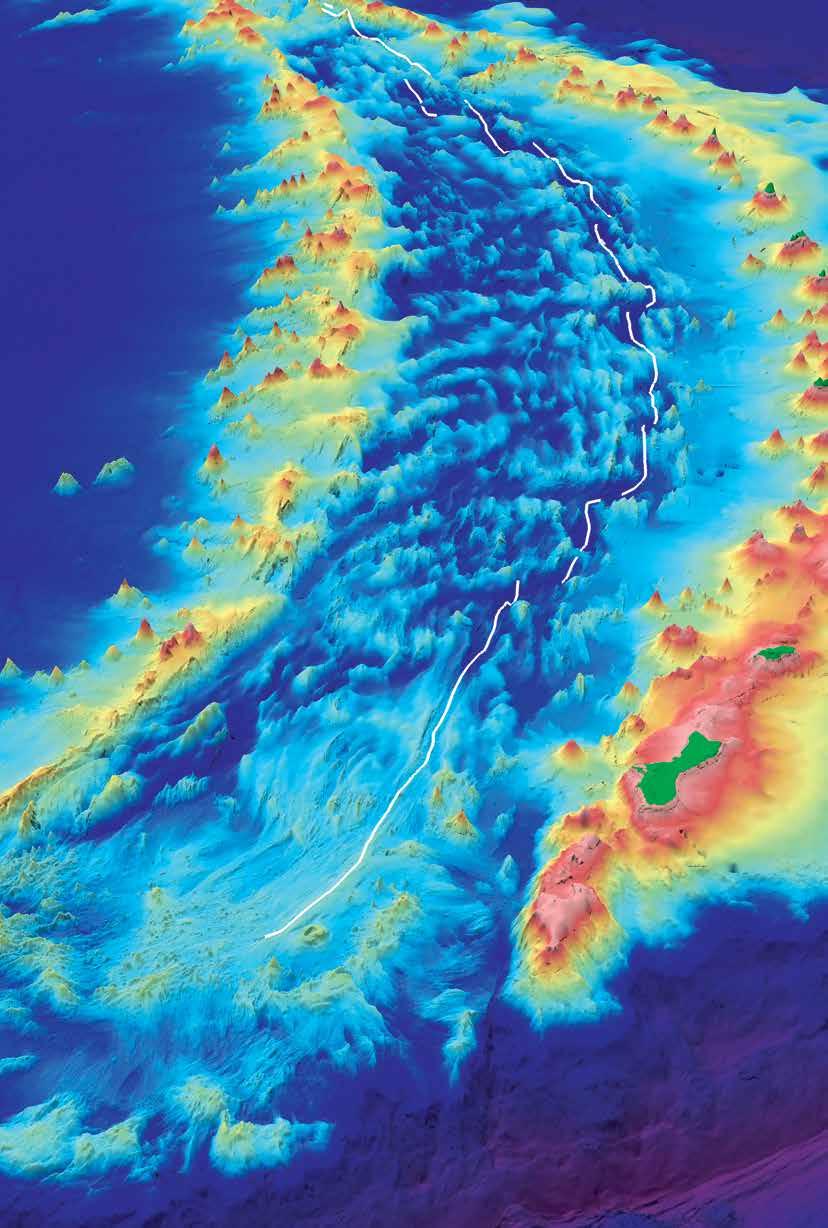





meeting people where their interests lie.”
Launched in 2015, the Artist-at-Sea program invites creators from diverse disciplines to join the expeditions, and pairs them with leading marine scientists on board. Observing cutting-edge marine research, the guest artists leverage their experiences to forge new works of art during their residency. To date, 48 artists have showcased voyageinspired pieces in virtual galleries and global venues such as Centro Ciência Viva science museum in Lisbon, Portugal, the 2021 United Nations Climate Change Conference in Glasgow, Scotland, and soon to be at Art Basel Miami Beach.
Aboard the Dynamics of Sinking Microplastics mission in August 2023, through the Ocean Rising program, artist Shan Hua worked in virtual reality to design a creature based on the ship’s CTD, a sensor-based instrument that measures the seawater properties of Conductivity, Temperature, and Depth. Vogue China is producing a video series that follows Hua’s on-board journey as she blends science and art to explore the interplay between natural shapes and human emotions.
In partnership with the Nekton Foundation, Ocean Rising designs collaboration opportunities that mesh marine science narratives with major sectors of popular culture, namely through workshop-driven projects. The first two events in the series, held in London in 2022, gathered top experts in fashion and music to brainstorm ways to weave deep-sea imagery and science themes into their work. Upcoming
workshops in sports, gaming, writing, food, and literature—and the growing Ocean Rising Alliance network of collaborators—are helping to spark a global awareness of the ocean. As part of said outreach, Schmidt Ocean Institute and Hotel Casa del Mar have also formed a strategic alliance to open The Conservatory, to assist in amplifying their state-of-the-art efforts toward oceanic research and education. The Conservatory will offer specialty menus consisting of selections from land and sea identified by conservationists as both wild and overly abundant.
Underscoring all of Schmidt Ocean Institute’s efforts is the desire to indulge people’s sense of curiosity and wonder. “Some of the most fundamental questions about our planet, our life, and our climate are still mysteries,” says Executive Director Dr. Jyotika Virmani. “So the greater insight we have into what is happening beneath the waves, the more we will be inspired to care for and ensure its health— which is so intricately linked to our own.”
Follow @SchmidtOcean on Facebook, Twitter, and Instagram, and visit @SchmidtOcean on Youtube for video and to watch exploration live.
38
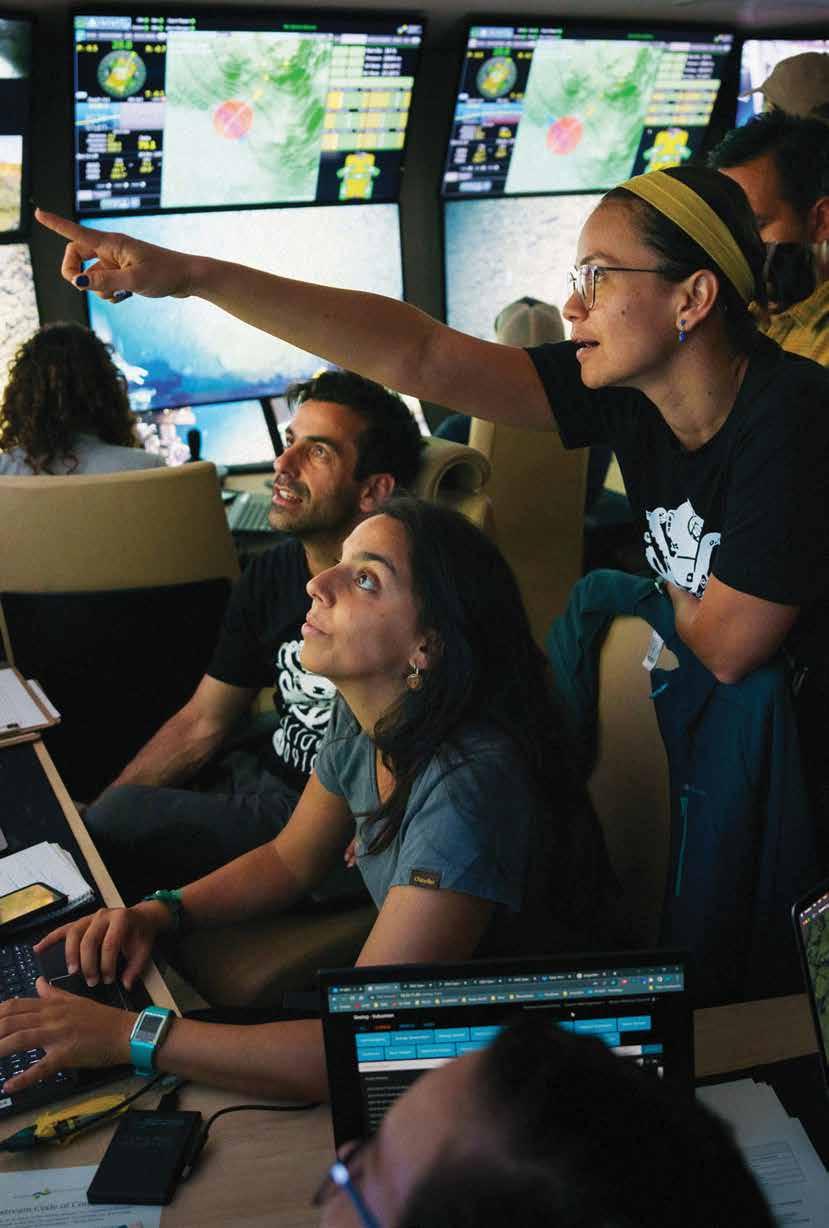

image courtesy of Dog PPL
“
People love to say, ‘A private club for dogs? That’s so L.A.’”
WELLSPRING
And that’s a good thing.
A members-only social club for pups and their owners, Dog PPL opened two years ago in a long-empty parking lot in Santa Monica, turning what was once solid asphalt into an urban oasis full of wide-open Astroturf, doggie splash pads, and bacon-scented bubbles. The club also offers plenty of places for people (and dogs) to lounge or to work, a cafe and bar if you want to grab some people food, and even a broad calendar of social events like movie nights, disco parties, yoga (with your dog) and trivia contests.
The idea for Dog PPL began five or so years ago when co-founders Alex Esguerra and Liam Underwood struck up a conversation while watching their dogs play at a park in downtown Los Angeles. Why, they wondered, weren’t there more dog parks in the city? And why were the ones that are open so hit-or-miss? All too often in L.A., dog parks are glorified dirt pits, and a mix of the unpredictable—dogs that might be aggressive, wild, or otherwise unsupervised. In them they found spaces that weren’t cleaned often enough, or drinking fountains that rarely worked, Esguerra and Underwood dreamed of a place, they say, where dogs
would be safer—and where their owners could feel at ease. An experiential designer and a videographer by trade, respectively, Esguerra and Underwood started working through the idea in their free time, dreaming up a concept.
“It started with the simple idea: ‘What if we got a tiny block of land and charged all our friends $10 to come?,’” Underwood says. “Then it turned into, ‘What if we got a shipping container, and turned that into a cafe?’ and ‘How do we keep the dogs safe?’ We realized we’d need to have their vaccine records, so we’d have to have a front desk person to check people in. Over time, it just built into what it needed to be.“
Today, Dog PPL boasts hundreds of doggy members, all of whom made it through a rigorous health and temperament screening to be admitted to the club. Owners pay $120 a month for access to the club and most of its activities, as well as amenities like high speed wi-fi, baskets full of dog cologne and branded poop bags, and on-site “rufferees” to supervise all that doggy roughhousing. There’s grooming on-site Fridays and
42
images courtesy of Dog PPL Santa
Has Gone to the Dogs
text by Marah Eakin
Monica





46

Saturdays, and the grounds are routinely sanitized and deep-cleaned, lest things get a little too funky.
There’s really no detail of Dog PPL Underwood and Esguerra haven’t thought about, from bringing in dog expert Robert Cabral before opening to both checking out the space and giving them advice on how to train their rufferees to making sure all staff members know both human and dog CPR. Esguerra says he and Underwood have become like “sponges” for dog information, absorbing the latest research on dog psychology and caninefriendly design and putting it into immediate action. “Any day we learn something new, we implement it,” Esguerra says. That doesn’t just apply to dog brains, either—the co-founders have also worked to stay on the edge of technology in terms of waterless cleaning solutions, solar power, and even sending off all the club’s excess dog hair to be made into mats to clean up oil spills.
The result is a space that has turned out to not just be good for dogs, but also for people. “Post-pandemic, people are longing
for connection outside of digital spaces and Zoom calls,” Esguerra says. “They’re dying to be around other people but currently, as a city dweller, your options are go to a bar and get drunk, go to a restaurant, or maybe join some sort of member’s club, but that’s not really that targeted. Where do you go to meet like-minded people?”
Meeting someone at Dog PPL, Underwood says, means you know, at the very least, they absolutely love their dog. “When you come into this space, it instantly breaks the ice,” he explains. “You can say ‘How old is your dog? What breed are they? What’s their name?’ The social aspect just evolves from there.” Some Dog PPL members have become friends outside the park, and more than a few love matches have sparked on site as well. “Alex and I have promised that, if a couple meets here and wants to have their wedding here, we’ll facilitate it,” Underwood says.
The club is also working to connect rescue dogs with new owners, launching Canine Rescue Club with an eye toward getting more longterm shelter residents into their forever homes.
48
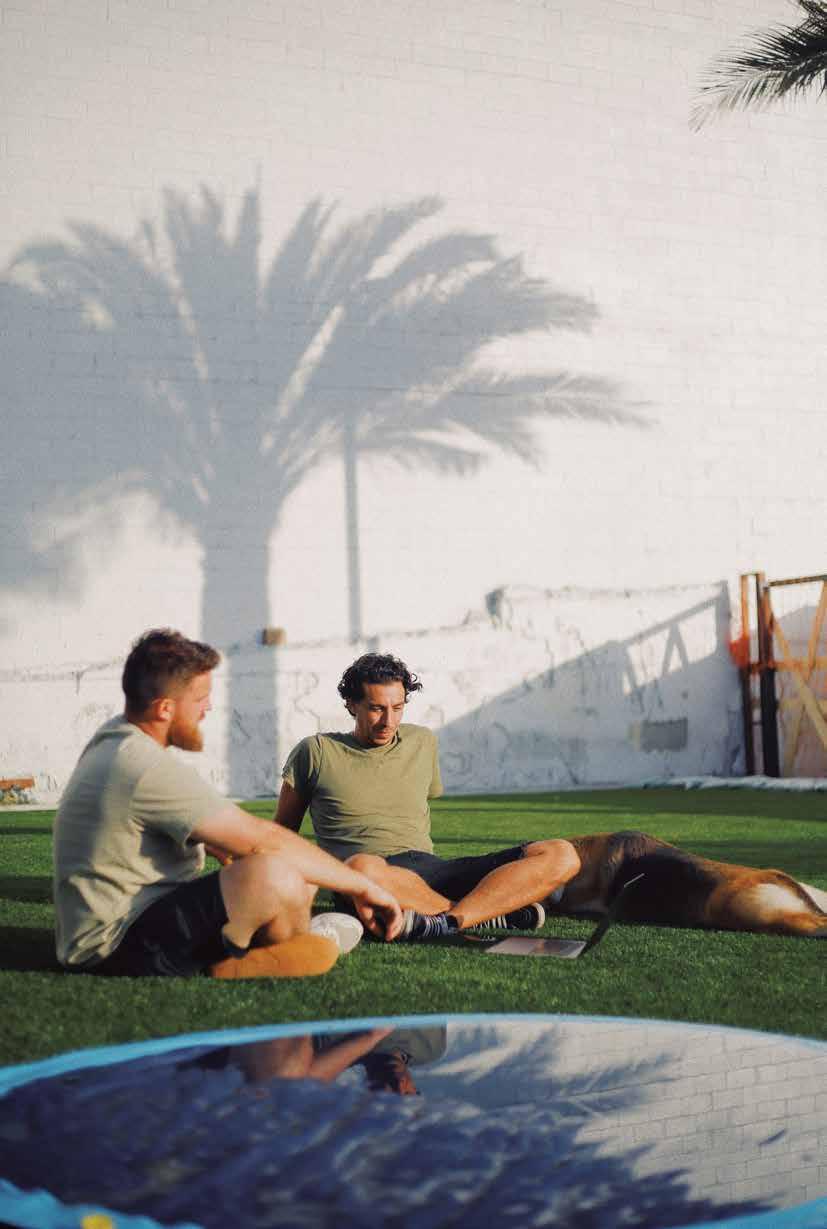




Frequently they’ll invite rescue dogs to come play, outfitting them in “adopt me” vests and putting out well-produced videos about the dogs’ best qualities that their members can share. Given most of Dog PPL’s canine members are mixed breed or rescues already, the advocacy is a natural fit for the club, which Underwood says is about “helping dogs above all else.”
“We just want the world to experience what we’ve built here in Santa Monica,” Esguerra says. “People love to say, ‘A private club for dogs? That’s so L.A.,’ but once you see it, you realize it’s just a beautiful, amazing, relaxing outdoor space where everyone is happy and living their best life with their dogs.”
54

Boeing 747-400 Nose Loader service and Ad Hoc charters on demand. Connecting LAX and HNL For more information, a free quote or to book online visit pacificaircargo.com or call 213.568.1977 AIR FREIGHT SPECIALISTS EXCEEDING ALL EXPECTATIONS daily with daily connections to Neighbor Islands and weekly service to Pago Pago and Guam.
A subculture thrives by the beach in Santa Monica.
Some of the collaborations are so headscratchingly bizarre, it’s OK to wonder whether or not they’re real. The Cinnamon Toast Crunch Kyrie 4s from Nike? That’s a spoof, right? Some meta commentary on late capitalism, a not-so-subtle critique of conspicuous consumption? The Grateful Dead X Nike Dunk Low SB “Orange Bear,” the Shoe Surgeon and Los Angeles Laker star power forward Anthony Davis teaming up on a high top basketball sneaker collab to promote … Ruffles potato chips? Clearly those aren’t real.
Right?
Wrong. They’re real, alright. See also: highly coveted and extremely collectible. Sneakerheads in the know scour online auction sites like Grailed, Stock X or Nike’s popular (and popularly scandalous) SNKRS app or stand in long lines overnight to buy a pair of these rarities at various drops. Kicks that meet a certain criteria—a mix of hype, historical significance, resale value, and of course, genuine artistry—are some of the most desired accessories in the world.
News outlets dedicated to the culture like Complex, Hypebeast, and HighSnobiety keep tabs on every facet of this growing fascination.
“Sneakers were always function over fashion, then they became fashion,” James Bond (real name—we’ll get to him in a moment), owner of Sneakerhead kingpin Undefeated, said in a YouTube interview.
But that’s not exactly correct. In fashion, trends come and go with the seasons, but collecting sneakers has transcended style, and become a full-fledged subculture where designers like Salehe Bemburry and the late Virgil Abloh lead the cutting edge of design and sartorial artistry. In Santa Monica you can see the subculture in full bloom at shops like Bond’s Undefeated (2654 Main St) and Shoe Palace (210 Santa Monica Blvd), where sneakerheads can be found emptying their wallets and obsessing about copping the latest drops.
The former’s first LA outpost opened in 2002 when co-owners Bond and Eddie Cruz recognized a gap in the market, and
56
text by Brian McManus
Get Your (Collector) Kicks on Route 66
images by Tim Aukshunas, Adrian Hernandez, Irene Kredenets, Erik McLean, and Nadya Nada

rushed in to fill it in order to help collectors of rare and unique sneakers find what they were looking for—“a well edited sneaker store, but also a brand that promotes affluent aspirational lifestyle based on our culture,” Bond told Complex in 2014. They’ve since played a role in nearly every sneaker trend over the last two decades, and, according to streetwear bible Hypebeast, have “created several collaborative Nike SB Dunk silhouettes during the Dunk hype, have collaborated with adidas’ top-tier Consortium project on multiple occasions, and their military-inspired Air Jordan 4 collaborative model is one of the most coveted special-edition sneakers of all time; in 2016, a pair sold for over $18,000.”
With releases of hot brands and limited collaborations happening more frequently now than ever—what used to happen once a month can now take place every week—it can be hard to keep up.
Of course, sneaker collecting isn’t just about acquiring the latest releases. It’s also a way to stand out, a form of self-expression. Collectors don’t only see their sneakers as fashionable accessories; they view them as
an extension of their identity. Sneakers are a canvas for individuality, allowing wearers to stand out and make a statement.
Enter Ocean Park Customs.
Rohan Shah got bit by the sneaker bug early. Real early. Like, at age 12. Now, at 13-yearsold, the artist and shoe fanatic customizes shoes for friends and paying customers under the Ocean Park Customs banner. It came naturally. The Santa Monica local always loved art and sneakers—”I played basketball and was really into unique shoes that stood out because being unique is one of my most precious values,” he says.
He saw a YouTube vid of someone using paint markers to customize sneakers, and was blown away, and had to try it for himself. Now, just a year in, he’s done sneakers for family, friends, paying customers, and DVMN PIGEON, one of the finalists on the hit HBO reality series on streetwear, The Hype. His favorites include a pair of surf-themed shoes he designed for a friend’s Bar Mitzvah.
Ocean Park Custom’s tagline is “Art that you can wear,” and that sums up the entire
58
Right: Rohan Shah of Ocean Park Customs eyes his work. Image by Tim Aukshunas.
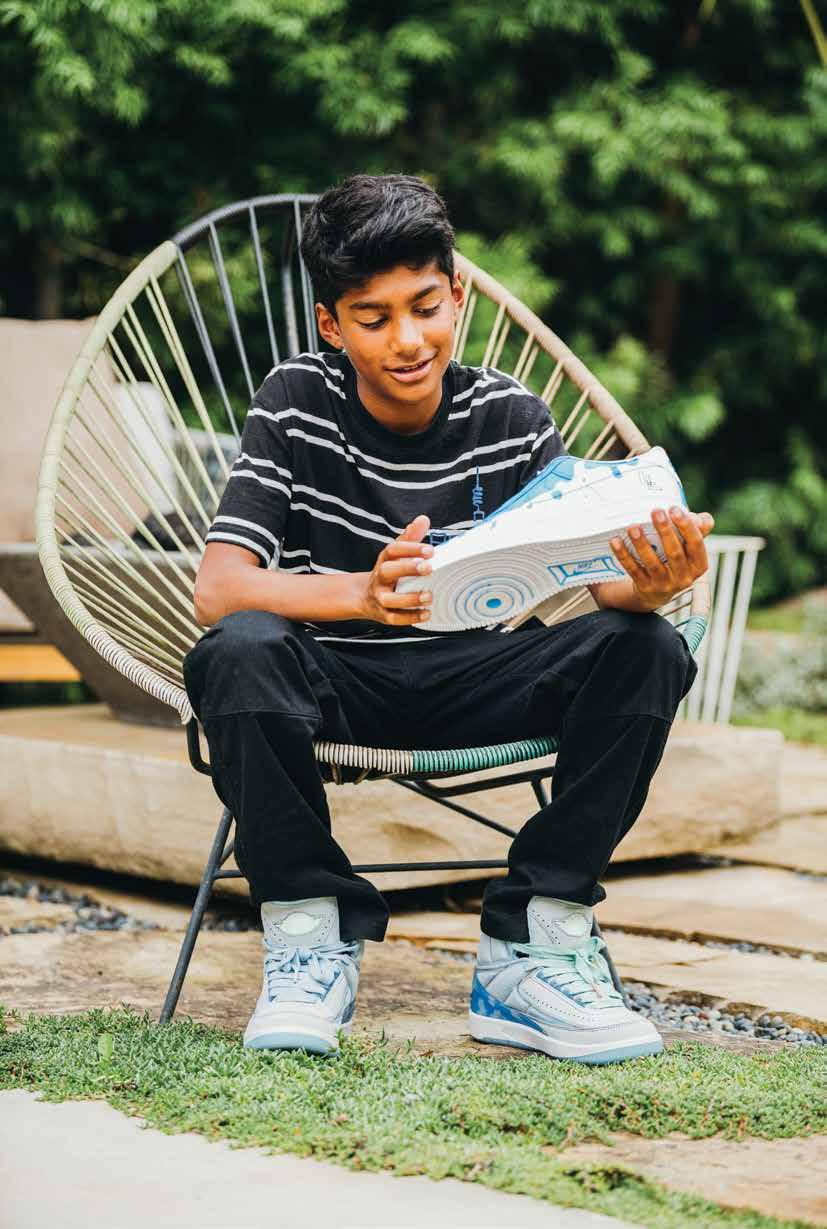
 Above: Shoe Palace in Santa Monica. Image by Tim Aukshunas. Right: New Balance + designer Salehe Bembury “Water Be the Guide” collaboration. Image by Nadya Nada.
Above: Shoe Palace in Santa Monica. Image by Tim Aukshunas. Right: New Balance + designer Salehe Bembury “Water Be the Guide” collaboration. Image by Nadya Nada.


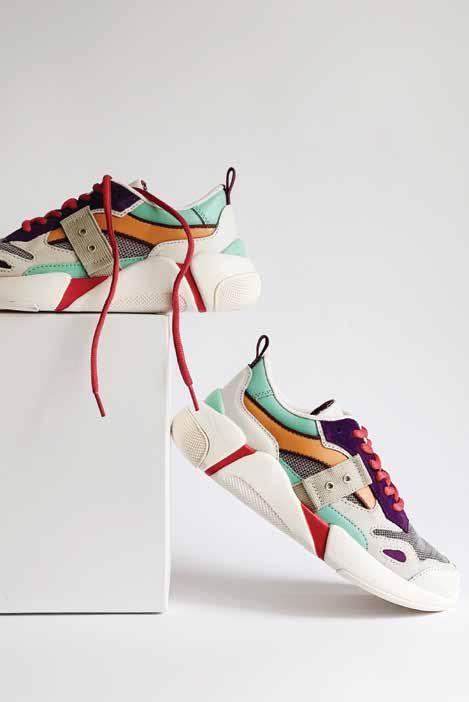
Sneakerhead movement pretty succinctly, no matter the motive of the collector.
High-end sneakers often feature distinctive designs, materials, and colorways. They serve as a means for self-expression and creativity, whether it’s matching sneakers with an outfit or customizing them to reflect personal style. The right pair of sneakers can elevate an entire look, showcasing a person’s uniqueness and flair.
For many collectors, high-end sneakers are more than just fashion; they are wearable art. They appreciate the craftsmanship and detail that goes into creating each pair. The combination of form and function, style and comfort, and the exclusivity of owning a limited edition make high-end sneakers an enticing choice for those, like Shah, who want to set themselves apart from the crowd.
64
Right: Highly coveted pair of Nike Air Max. Image by Adrian Hernandez.

Why Santa Monica is paradise for art lovers.
Perhaps it was the quality of the light, the palpable sense of freedom and possibility or simply an abundance of affordable raw space that first drew significant 20th-century artists like Ray Ray and Charles Eames, Richard Diebenkorn, Sam Francis, Ed Ruscha, and John Baldessari to Santa Monica and the surrounding area. Whatever the reason, their choice to take up residence during important stages of their careers undeniably helped place Santa Monica firmly on Southern California’s mid-century art map.
Today, the city hosts over 120 museums, galleries, and public art installations within its eight square miles, more per capita than any city other than New York—a testament to the community embracing the transformative power of art.
“With a rich collection of public art and a diverse creative population, Santa Monica is dedicated to the belief that art is a basic city service and is essential to our city’s continued vitality,” proclaims the city’s Cultural Affairs office. Beyond serving as a central hub for grants, competitions, and other resources aimed at both working and
aspiring artists, the group meticulously catalogs Santa Monica’s extensive public art collection alongside an interactive map and a regularly updated list of ‘must-see’ art pieces and their respective locations. Here, we shine a light on some of the pillars of the Santa Monica art scene. Each is worth a visit.
Bergamot Station Arts Complex
The city is home to a notable concentration of world-renowned art galleries, especially in Bergamot Station, a collection of 18 galleries clustered together on a nearly 5-acre repurposed train yard. Bergamot Station welcomes the community to a uniquely curated art experience and regular events, as well as providing a little oasis in an industrial part of Santa Monica.
Robert Berman Gallery
“The independent galleries at Bergamot Station Arts Center showcase the most current developments in contemporary and modern art, offering a space, free to the public, to immerse themselves in an art experience,” explains Robert Berman.
66
Art of the Matter
text by Urs Baur
images
courtesy of Tim Aukshunas
Right: Robert Berman Art Projects

When he relocated the eponymous Robert Berman Gallery—originally founded in the late ‘70s—to its current premises at Bergamot, Berman became one of the inaugural tenants of the art complex, occupying the two spaces he still holds today. Berman also operates Santa Monica Auctions, an internationally renowned auction house. Berman’s gallery was among the first to showcase works by seminal artists such as Keith Haring, Raymond Pettibon, William S. Burroughs, and Man Ray.
Gallery XII
Galerie XII opened in 2018. The gallery is the Santa Monica location of its Paris affiliate, also owned by Valerie-Anne Giscard d’Estaing, a publisher, who entered into the gallery business in 2007 with a focus on contemporary photography. D’Estaing credits the communal spirit and sense of place she experiences at Bergamot Station for her decision to open her gallery here. “There’s close collaboration between all of us tenants, there’s good energy. Of course everyone is competing, but in reality our collective presence broadens the offering to visitors and potential buyers.”
Lois Lambert Gallery
Lois Lambert Gallery represents over 100 artists from the United States, Latin America, South America, Europe and Asia. According to Lambert herself, she is “dedicated to bringing thoughtful, sometimes provocative, and always original art to the public.” Over time she’s added an upstairs gallery to create more exhibition space, and also curates a
gallery store, where she sells artist-made objects, ceramics, and other unique gift items. “I’ve been at it for 35 years,” she says. “I still love the gallery and discovering artists. I wouldn’t want to be doing anything else.”
While Santa Monica’s galleries contribute greatly to the community, it is arguably Santa Monica’s non-profit arts institutions that have the most profound impact on the city’s essence.
18th Street Arts Center
”At 18th Street, we’re committed to creating opportunities for artists to help build the kinds of healthy communities they want to live in,” Jan Williamson, Executive Director of 18th Street Arts Center says of the longest running artist residency in Southern California. The center hosts about 60 artists concurrently and helps the city manage 40 low-cost artists’ studios at the Santa Monica Airport, where they also host monthly open-studio shows. It adds to the community’s “identity and sense of pride,” she boasts.
As an example of creative placemaking, Williamson points to 18th Street’s ongoing Culture Mapping Project. “Essentially it is a community produced map, highlighting the history and cultural assets of a given neighborhood.” Cultural assets can be people, places, events, and organizations, both past and present, that serve as anchors within any given community. In short, things “that define the identity of the neighborhood, according to the people who live there.”
68
Right: A collection of quilts on exhibit at 18th Street Arts Center.

 This page and right: The art at Gallery XII.
This page and right: The art at Gallery XII.

Once the stories are collected, the center pairs artists with community partners to initiate projects that address these specific needs or desires, and in the process inform various community policies and programs. Since its inception in 2015, the center has implemented about 70 of these culture mapping projects in Santa Monica alone, and recently have been funded to expand the program to other communities all across California.
It’s a testament to Williamson’s belief that art plays an important role in community engagement and well-being. “Especially now, people are searching for meaningful connections and a sense of belonging—and arts and culture provide an important way of doing that,” Williamson concludes.
Frieze Los Angeles
Another noteworthy event returning to Santa Monica for its fourth edition is “Frieze Los Angeles,” the prestigious international art fair, featuring over 120 of the world’s leading galleries. “Santa Monica Airport was selected for its abundance of space and flexibility that meets our ambitious plans for
the fair, allowing us to welcome innovative art and ideas across all forms of creativity,” explains Christine Messineo, director of Frieze New York and Los Angeles. Frieze Los Angeles takes flight February 29 through March 3, 2024.
72
Right: Lois Lambert Gallery


image
Rick
by
Loomis
“
If a city doesn’t have history, arguably, it doesn’t have meaning.”
PEOPLE
The
Santa Monica Conservancy preserves the past to help teach future generations.
“There’s a common misconception that conservation is anti-development,” says Catherine Azimi, Communications Manager for the Santa Monica Conservancy. Azimi and Executive Director Kaitlin Drisko are seated around a small desk in the iconic Shotgun House, the Conservancy’s headquarters, aka the Preservation Resource Center at Second Street in Ocean Park—an example of historic preservation via adaptive reuse. “In truth, we often collaborate with developers to ensure that projects are historically sensitive. Historic preservation can be entirely compatible with the needs of an evolving city,” Azimi suggests.
The Santa Monica Conservancy was founded in 2002 as a grassroots, nonprofit organization, dedicated to promoting widespread understanding and appreciation of the cultural, social, economic and environmental benefits of historic preservation. Since then, the Conservancy has emerged as one of the leading voices in the city’s conservation movement. Under the guidance of Executive Director Kaitlin Drisko, a seasoned expert in historic preservation, the Conservancy
is poised to meet current challenges. “Conservation projects are not only about structures, they are also about people,” Drisko says. “I like to think we connect people across time, and in order to truly understand present day Santa Monica one needs to understand the past.”
Indeed, long before its modern landmarks, before the hustle and bustle of the pier and the promenade, before the high-end shops and restaurants, the multimilliondollar Spanish colonial revival homes around Montana Avenue, the modest California bungalows, and the youthful energy emanating from its educational institutions, the area was home to the Tongva people; their villages and sacred sites, the only man made markers dotting this landscape.
As time’s wheel turned, their settlements were displaced by a built environment accommodating the needs of the Spanish colonists, Mexican ranchers, and later, the waves of American settlers who anchored their dreams on this coastal stretch of land. As the pace of development hastened,
76
Looking Forward Through History
text by Urs Baur images by Rick Loomis
Right: Catherine Azimi, Communications Manager of Santa Monica Conservancy, inside the Preservation Resource Center
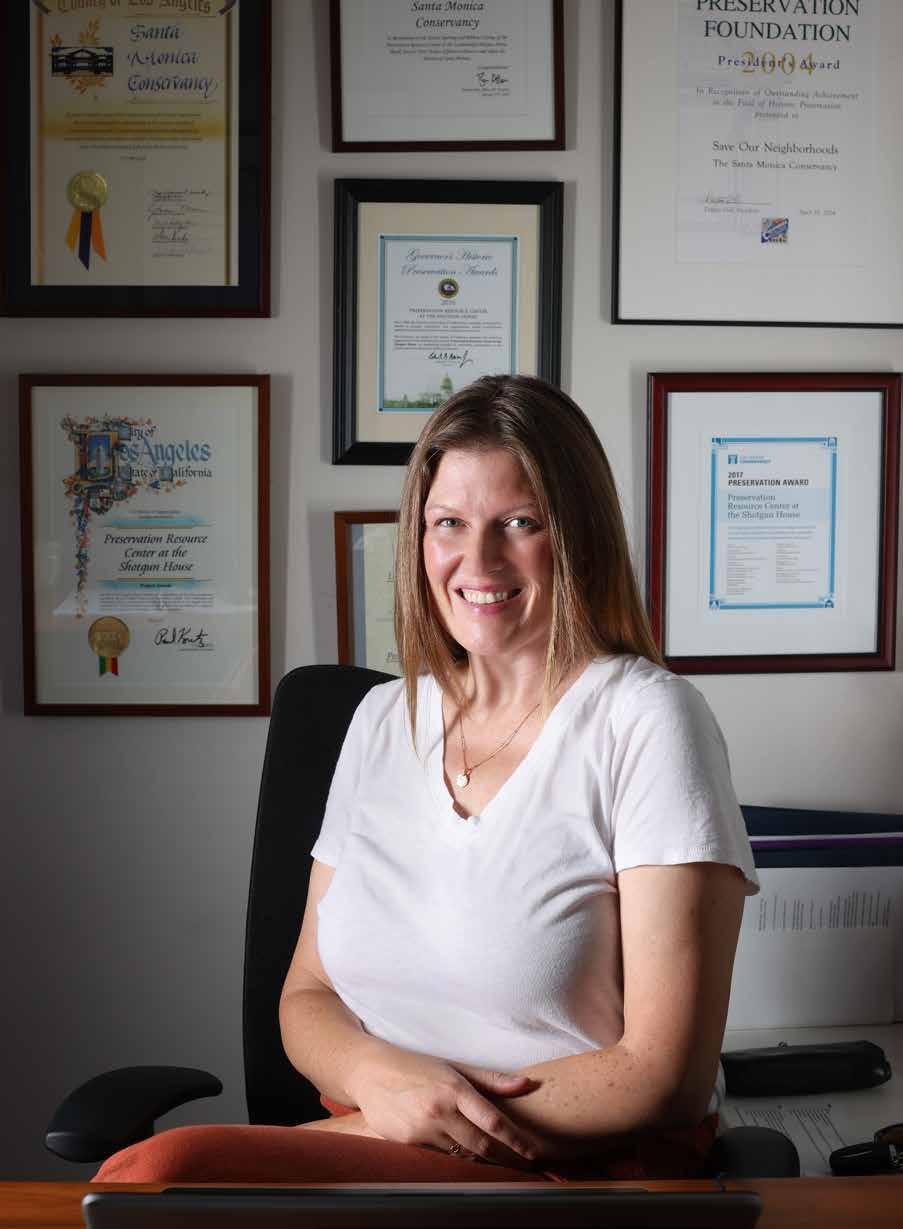
 This page: The historic “Shotgun House” Preservation Resource Center. Right: Santa Monica Conservancy Executive Director Kaitlin Drisko poses with model of Shotgun House.
This page: The historic “Shotgun House” Preservation Resource Center. Right: Santa Monica Conservancy Executive Director Kaitlin Drisko poses with model of Shotgun House.

especially during the mid-late 20th century, most of the sites bearing witness to this history would have been lost, were it not for the efforts of those advocating for the importance of preserving and honoring our collective story.
While the Conservancy plays an important role in protecting important sites of the past, its deeper mission is creating community around a sense of a shared history, according to Drisko. In recent years, the organization has played a crucial role in facilitating public discourse around fundamental questions such as what constitutes historical significance and how best to support and align the diverse interests of the various stakeholders.
Inspired by a renewed focus and interest on the many facets of Santa Monica’s cultural heritage, in 2020 the Conservancy launched a virtual series, Santa Monica Mosaic, which gives voice to underrepresented and ‘forgotten’ histories. Episodes feature representatives from a variety of different backgrounds speaking to their own lived experiences, including one JapaneseAmerican family’s story of assimilation back into the city post-internment during WWII, a commemoration of the African American experience at the Belmar Triangle through the Belmar Art + History project, and a chronicle of European Jewish migration to the ‘promised sand’ of Santa Monica.
“Conservation can no longer be seen simply as a matter of preserving structures, but also ensuring that the tales they hous e tales from all of the city’s communities—are valued and given voice,” Drisko explains. “Adaptive reuse is key to balancing historical preservation with modern needs.” Azimi points to the former Sears building, historic Nikkei Hall, the Santa Monica Professional Building, and the Associated Telephone Building as examples of successful adaptive reuse projects that reimagine historic properties for contemporary use.
Under Drisko’s leadership, the Conservancy is set for expansive community outreach. She’s especially keen on celebrating Santa Monica’s
upcoming milestones—its 150th birthday in 2025 and the influx of international visitors for the 2028 Olympic Games. “At its core,” she says, “the Conservancy believes in a simple yet powerful idea: A city that understands its past is better equipped to navigate its future.”
For those wanting to immerse themselves in Santa Monica’s rich cultural heritage, the Conservancy offers a variety of in-person, or downloadable self-guided tours, and virtual programs that invite visitors and locals alike to journey through time, from the Tongva settlements to modern-day marvels. Says Azimi: “What I’ve found in preservation is that people really are gratified to understand and have literacy around the built environment they inhabit because it gives people orientation… a sense of place. If a city doesn’t have history, arguably, it doesn’t have meaning.”
80
Right: Horatio West Court by Irving Gill at 140 Hollister Ave. Image by Rick Loomis.

Black Santa Monica’s rich history.
Santa Monica, with its iconic pier, pristine beaches, and vibrant culture, often conjures images of sun-soaked surfing and leisurely strolls on the boardwalk. Yet, beyond the well-trodden tourist paths and beachfront merriment, there’s a deeper history that often remains obscured. It’s a history that is as fascinating as it is significant—the history of Black Santa Monica.
Santa Monica is believed to be home to the first African American settlement in any seaside community in California. As the 20th century dawned, Black pioneers migrated from the Jim Crow South, seeking a fresh start in the sun-kissed coastal town. However, they soon encountered familiar obstacles— prejudice and de facto segregation. While the sun, sand, and surf beckoned, access was limited to Bay Street Beach, known as “The Inkwell,” a two-block stretch of shoreline just south of the iconic Pier.
It’s a history Robbie Jones, founder of Black Santa Monica Tours, is determined to tell.
“Our parents and grandparents didn’t always talk about these stories, because that history was painful,” Jones says, walking the streets of the town she’s lived in some 60-plus years. “Even people who lived here were like ‘There’s nothing [historical] here.’ I knew that the history was interesting, though, and that people needed and wanted to know.”
That want is being satisfied by several in the community.
Alison Rose Jefferson, a historian with a PhD, has dedicated herself to researching and documenting the history of Black Santa Monica. Her comprehensive 155-page essay, “Reconstruction and Reclamation: The Erased African American Experience in Santa Monica History,” developed for the Belmar History + Art project, and supported by the City of Santa Monica, delves into the early years of the 20th century. It vividly recounts the arrival of African Americans, the establishment of storefronts, and the development of neighborhoods.
82
the Hidden
text
Unearthing
Legacy
by Marah Eakin
images
by Rick Loomis and courtesy of Santa Monica History Museum
Right: Robbie Jones of Black Santa Monica Tours. Image by Rick Loomis.

The Quinn Research Center (QRC), led by its Director, Carolyne Edwards, shares the responsibility of preserving this vital history. The QRC’s mission is to empower the community by promoting the study and research of Black family history and culture in the Santa Monica Bay area. Named after Dr. Alfred T. Quinn, the First African American School Teacher in the Santa Monica-Malibu Unified School District, the center boasts a treasure trove of documents and photographs left behind by Dr. Quinn. These valuable historical artifacts are now accessible to all through an online archive at Quinnresearchcenter.com.
There, the names of Santa Monica’s African American pioneers and their contributions come back to life. Names like Lloyd Allen, one of the first African American small business owners, who would later become the Recreation and Parks Director. Marcus O. Tucker Jr., the first African American presiding Judge at the Long Beach Municipal Court, whose father was also the first African American Doctor in Santa Monica. Hillard C. Lawson, the first African American Councilmember in the City of Santa Monica. Betty McCleary, one of the first African American “Rosie the Riveters” who supervised plane production during World War II. And Vernon Brunson, an architect who designed numerous homes in the Pico neighborhood, with his brother, Donald, the first African baby born in Santa Monica in 1907.
“All of these names and all of these wonderful people have helped shape our community,” says Edwards on TikTok, making the past accessible to a tech-savvy generation.
The revival of Black Santa Monica’s history extends to other modern technology, as well. Snapchat, in collaboration with the Santa Monica History Museum and QRC, introduced the exhibition “Broadway to Freeway: Life and Times of a Vibrant Community” in June 2023. Users of Snapchat can walk through the historic Broadway corridor and explore history through the app’s “Broadway History Lens.” This innovative approach allows users to
experience the sights and sounds of a vibrant community of color that once thrived before the construction of the 10 freeway in the 1960s.
Santa Monica Mayor Gleam Davis highlights the importance of preserving these stories. “So many of our marginalized communities are having their history erased, and what we want to do is avoid that,” she said in a video promoting the launch of the project. “Different groups have different stories to tell, and I think sharing all of those stories will make it easier for us all moving forward.”
For those who prefer a more personal touch, Jones continues to be the torchbearer for the cause in person.
Jones started Black Santa Monica Tours in 2004, following her grandmother’s passing. Her family home on 20th Street was a backdrop for countless stories, sparking her mission to share the history of Black Santa Monica with a wider audience. She wanted to ensure the legacy would live on for generations to come, not just through occasional family reunions or friendly requests but for anyone interested in the city’s African American history.
Jones estimates she has taken “thousands” of people on tours, revealing sites of immense cultural significance. She guides visitors through the Virginia Avenue Park, where the community still gathers today, and to “The Inkwell,” where, from 1905 to 1964, Black visitors found their only piece of shoreline.
On her tours, Jones passionately narrates the stories of her own experiences in the city, determined to connect the dots and share a narrative of unity. “I want people to understand that we’re all on this planet together. We need to know everyone’s story,” she says. Her work with local organizations, including the Philomathean Charity Club and the Committee For Racial Justice, highlights her commitment to community and history.
Jones’s next chapter unfolds in 2024 when she opens the Just Family Cafe and Coffee Bar. The café will serve her grandmother’s
84
Right: “A Resurrection in Four Stanzas” at Historic Belmar Park Monument. Image by Rick Loomis.


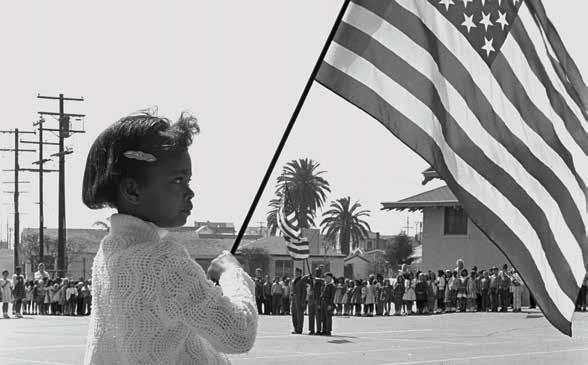


 Left from top: A bike rider cruises in front of “The Inkwell,” modern day. Image by Rick Loomis; Young girl holding an American flag during a parade on the playground of a school in the African-American community of Santa Monica, 1964. Image courtesy of Santa Monica History Museum; “A Resurrection in Four Stanzas” at Historic Belmar Park Monument. Image by Rick Loomis.
This page: Freedom Marchers and African-American civil-rights protesters demonstrating by the Santa Monica Post Office. 1964.
Left from top: A bike rider cruises in front of “The Inkwell,” modern day. Image by Rick Loomis; Young girl holding an American flag during a parade on the playground of a school in the African-American community of Santa Monica, 1964. Image courtesy of Santa Monica History Museum; “A Resurrection in Four Stanzas” at Historic Belmar Park Monument. Image by Rick Loomis.
This page: Freedom Marchers and African-American civil-rights protesters demonstrating by the Santa Monica Post Office. 1964.
recipes, showcase local history on its walls, and offer QR codes on tables to provide patrons with an interactive history experience. It will be a hub for community groups, book clubs, and a place where the past and present of Santa Monica intersect.
The cafe will be situated on the first floor of Brunson Terrace, a new affordable-housing development named after Santa Monica’s first recorded Black residents, Charles and Serena Brunson, who raised their two sons, Donald and Vernon, in the city.
The legacy of Vernon Brunson, the architectural designer, poet, and electromechanical designer for Hughes Aircraft, is celebrated in an exhibit at the Quinn Gallery, where Vernon’s influence on contemporary Black architects shines through.
As Jones aptly states, “We’ve come a long way, but there’s still a lot of room to grow.”
If you’re eager to delve into Black Santa Monica’s history, you can book a spot on a Black Santa Monica Tour through blacksantamonicatours.com. It’s an
opportunity to explore the hidden treasures of Santa Monica’s vibrant past and join the growing movement to ensure these stories live on for future generations.
88
Right: Vernon Brunson. The Brunson Family was one of earliest African American families in Santa Monica. Vernon’s parents moved to Santa Monica circa 1905, and had their children a few years later. Photo via 1969 courtesy of Santa Monica History Museum.
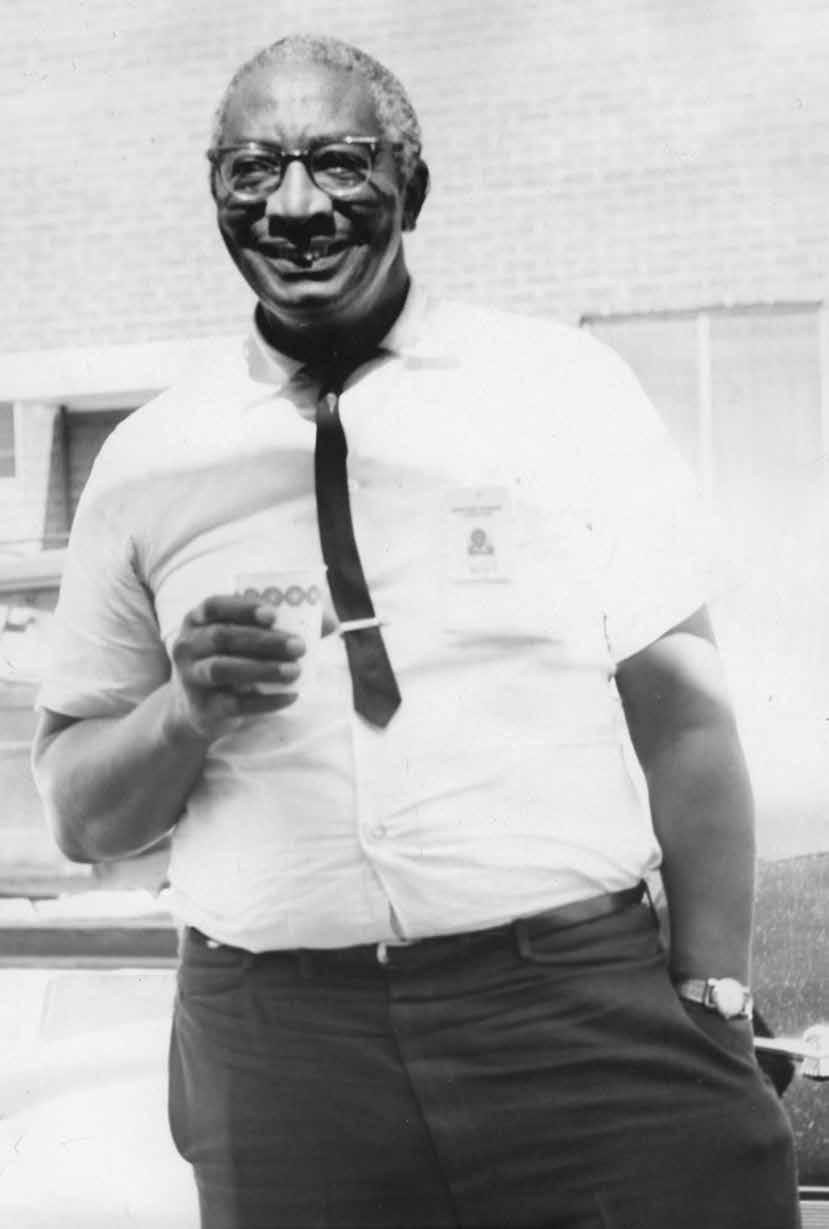
Embark on a culinary journey from Spain and its Balearic Islands to Italy’s enchanting Amalfi Coast. Terrazza Restaurant at Hotel Casa del Mar is a celebration of the rich culinary tapestry of the region, accented by seasonal favorites from California.
A Symphony of Flavors
Menu highlights include wild-caught Dorade, renowned for its tender, delicate flesh. Each skillfully butterflied, deboned, and lightly grilled in fine Italian olive oil and garlic.
One of Spain’s most emblematic delicacies, Iberico de Bellota is served on Barcelona “Pan de Cristal” with crushed tomatoes. Sourced from acorn-fed Iberian pigs, its unmistakable quality makes it a traditional favorite of the region.
There is a succulent Italian Crudo selection featuring Striped Jack and Black Snapper sliced perfectly to order. The Striped Jack is in a citrus miso sauce for brightness and umami with pickled Fresno chilies for some heat and house made oregano furikake.
Pastas are plentiful, highlighted by the Garganelli Pasta made from Italian Semolina
flour and eggs, coupled with fennel sausage made in house, charred broccoli, Calabrian chilies, and Parmigiano-Reggiano aged 24 months. There are vegetarian pasta selections as well.
European Lubina, a lean and flaky white fish grilled to perfection, is prepared for the table to share for those seeking a communal dining experience, as is the delectable Seafood Paella. A closely guarded Chef’s secret family recipe that bursts with colors and flavors.
Pairing Perfection: Crafted Cocktails, Fine Wines, and Stunning Sunsets
Each course at Terrazza can be expertly paired with artisanal cocktails, an international wine selection, or the resident mixologist’s signature sangrias. The combination of flavors will further elevate your dining experience, perfectly complemented by the backdrop of stunning Pacific sunsets.
Terrazza is open from sunrise to well past sunset, offering the ultimate Mediterranean epicurean adventure overlooking Santa Monica Beach and its iconic Ferris Wheel.
Terrazza Restaurant offers a taste of everything from wild-caught Dorade to Italian Crudo.
90
text by Armella Stepan
Where the Pacific Ocean Meets the Mediterranean Sea
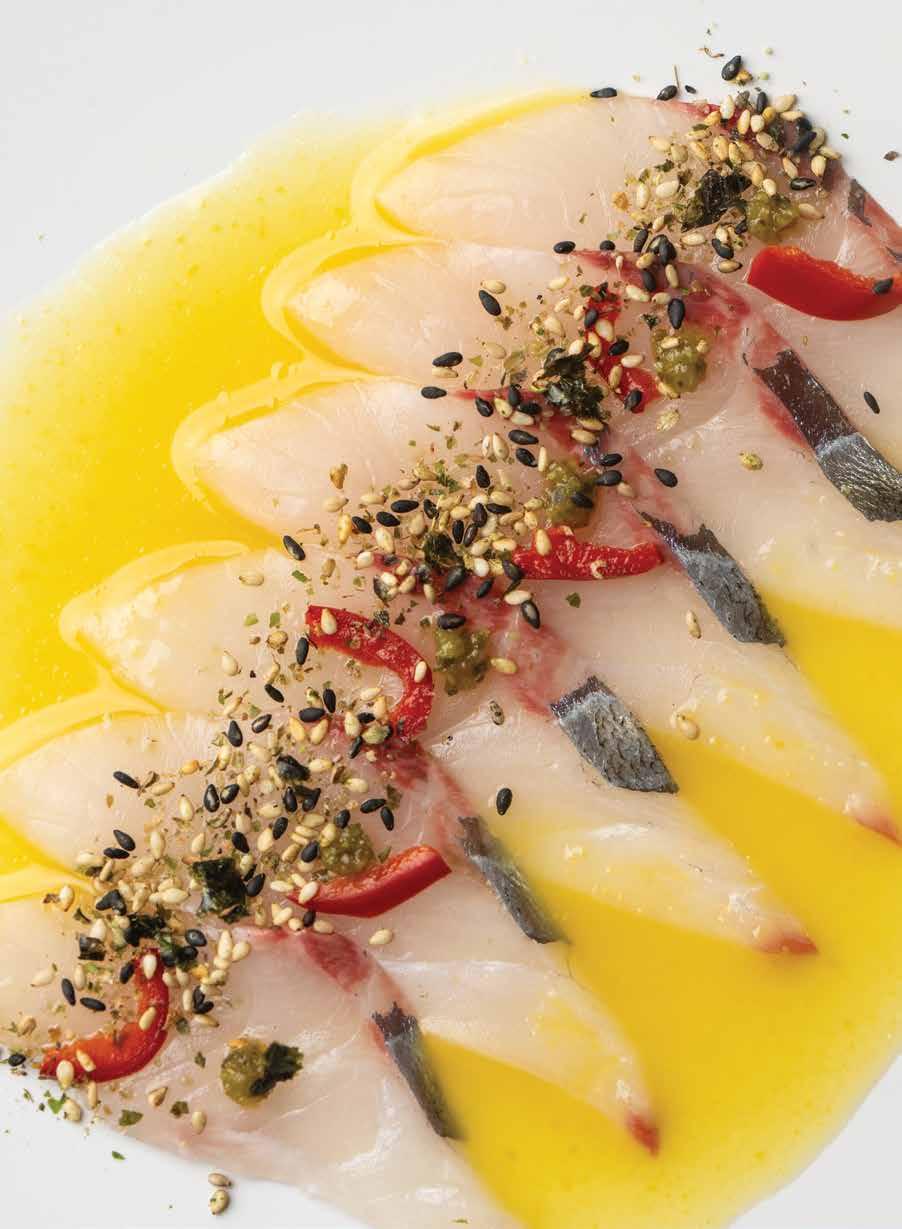


Southern California, with its reputation for endless summer, is a paradise for outdoor enthusiasts year-round. You know fall has arrived when temperatures level out around 70 and beach goers pack a light sweater for sunset. For others, alfresco activities may shift a bit inland. Here are just a few of the more popular endless summer activities beyond the beach.
Sunset Season - During the late fall and winter months the sun sets directly behind Shutters on the Beach and Hotel Casa del Mar. Nature’s most spectacular light shows of the year appear to waltz around the sky from October to January. Arrive early for a prime seat at either hotel.
Pedaling Paradise - Explore the eclectic charm of L.A. County’s coastal communities along the Marvin Braude Bike Trail. Also known as “The Strand,” the views of the Pacific are breathtaking and the breezes are perfect for keeping cool. Traditional and electric bikes are available for rent yearround from Perry’s on Santa Monica Beach.
Wine Country Revelry - Southern California boasts numerous wine regions that are only
a day trip away. From the tasting rooms in Santa Barbara to the vineyards of Malibu, wine lovers can dine al fresco with the perfect pairing. Wine excursions are particularly popular during harvest season (aka crush season) from August to October.
Desert Adventures - Southern California desert areas spring to life in late October. Joshua Tree National Park becomes an oasis for rock climbers and stargazers, while the Anza-Borrego Desert State Park offers fantastic opportunities for wildflower sightings during the cooler months.
Car Culture – Classic cars and scenic drives are embedded into the area’s DNA. Take a Porsche up to 100 miles per hour at the Porsche Experience Center, cruise along the majestic Pacific Coast Highway, or explore the Petersen Automotive Museum. The beach will be here when you return.
The beauty of Southern California lies in its adaptability to the changing seasons. Whether you are seeking the buzz of beachfront fun or the serenity of desert landscapes, Southern California’s temperate climate ensures your outdoor adventures never have to end.
94
Shifting Seasons
text by Armella Stepan
Après Beach










 MICHELLE MAIN DIRECTOR OF OPERATIONS - HOTEL CASA DEL MAR
MICHELLE MAIN DIRECTOR OF OPERATIONS - HOTEL CASA DEL MAR















 Above and right: Legendary surfboard shaper Jeff “Doc” Lausch hard at work.
Above and right: Legendary surfboard shaper Jeff “Doc” Lausch hard at work.





























 Above: Shoe Palace in Santa Monica. Image by Tim Aukshunas. Right: New Balance + designer Salehe Bembury “Water Be the Guide” collaboration. Image by Nadya Nada.
Above: Shoe Palace in Santa Monica. Image by Tim Aukshunas. Right: New Balance + designer Salehe Bembury “Water Be the Guide” collaboration. Image by Nadya Nada.






 This page and right: The art at Gallery XII.
This page and right: The art at Gallery XII.




 This page: The historic “Shotgun House” Preservation Resource Center. Right: Santa Monica Conservancy Executive Director Kaitlin Drisko poses with model of Shotgun House.
This page: The historic “Shotgun House” Preservation Resource Center. Right: Santa Monica Conservancy Executive Director Kaitlin Drisko poses with model of Shotgun House.








 Left from top: A bike rider cruises in front of “The Inkwell,” modern day. Image by Rick Loomis; Young girl holding an American flag during a parade on the playground of a school in the African-American community of Santa Monica, 1964. Image courtesy of Santa Monica History Museum; “A Resurrection in Four Stanzas” at Historic Belmar Park Monument. Image by Rick Loomis.
This page: Freedom Marchers and African-American civil-rights protesters demonstrating by the Santa Monica Post Office. 1964.
Left from top: A bike rider cruises in front of “The Inkwell,” modern day. Image by Rick Loomis; Young girl holding an American flag during a parade on the playground of a school in the African-American community of Santa Monica, 1964. Image courtesy of Santa Monica History Museum; “A Resurrection in Four Stanzas” at Historic Belmar Park Monument. Image by Rick Loomis.
This page: Freedom Marchers and African-American civil-rights protesters demonstrating by the Santa Monica Post Office. 1964.





